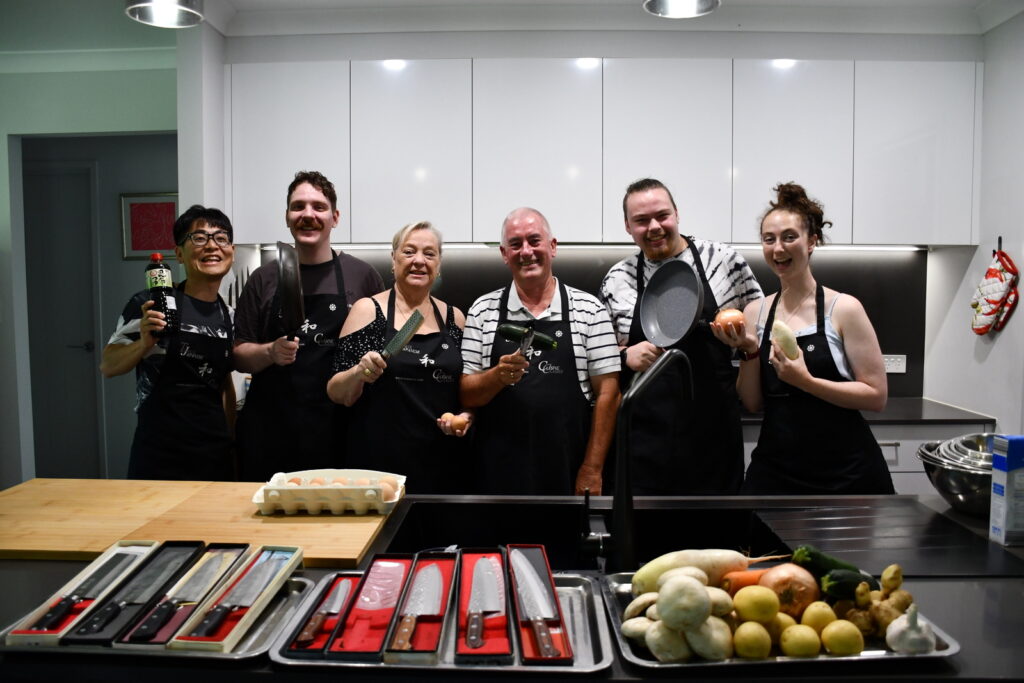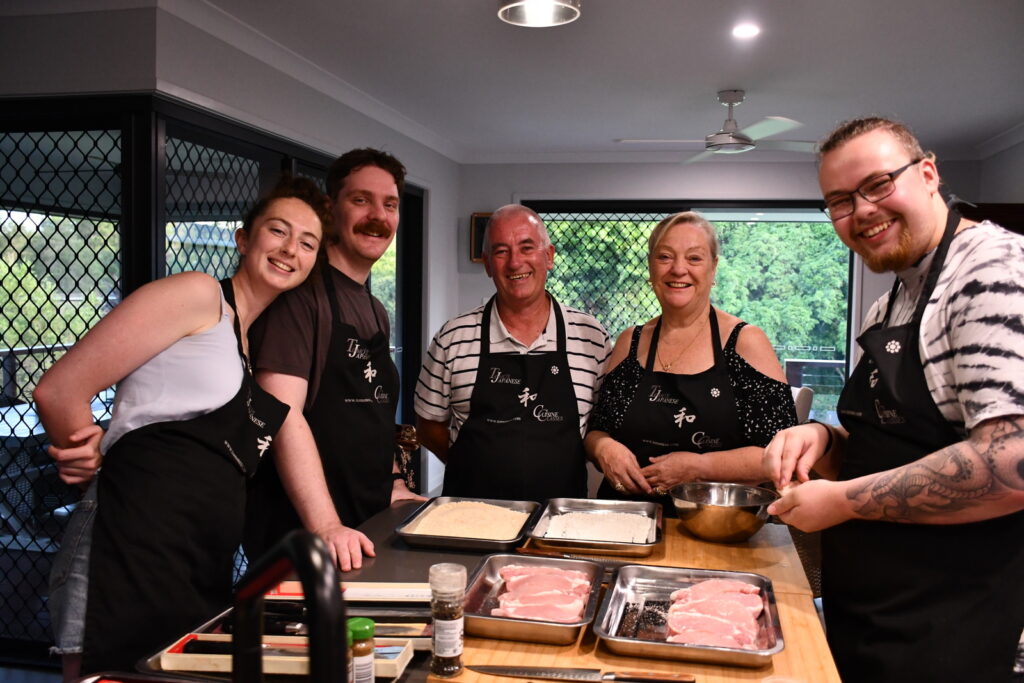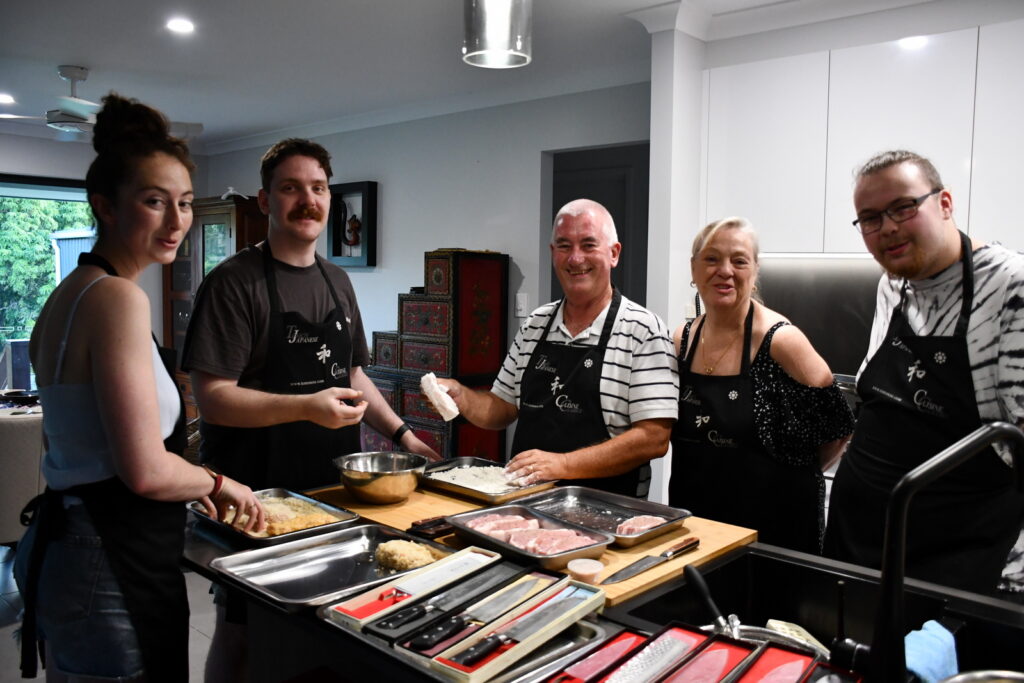Behind the Scenes of our Family’s Japanese Cooking Class: A Sneak Peek
The customers this time were a family of five, consisting of both parents, two sons, and one son’s girlfriend. They were gifted a voucher card from their parents last Christmas and attended a cooking class held at their parents’ home. The youngest son works as a pastry chef at a Mediterranean restaurant, while the older son and his girlfriend had previously visited Japan and were interested in Japanese cuisine and cooking methods. The father had little cooking experience, but he helped out with all his might to create family memories. The youngest son was skilled in everything from knife handling to preparation and cooking.
What I noticed on the day was that cooking skills vary depending on the person’s position and level of experience. My challenge for this event was how to make it enjoyable for people with different skill levels. I learned that:

1.Japanese cuisine values simplicity and precise execution.
During this cooking class, we created tonkatsu and chicken curry dishes. We emphasized the importance of taking our time and following the basics, such as the proper way to cut vegetables, the angle to use, how to apply breadcrumbs, and how to wash rice. We approached the class from a perspective different from Australia, but it allowed us to ensure that each step was performed correctly, even if it meant working slowly.
2.We delegated tasks based on each individual’s strengths.
We entrusted the finer details of cutting to the youngest son, and for easier tasks, we asked the father for help. Each person contributed to the best of their abilities, and this approach helped increase the overall teamwork. As this was the first time the son and father cooked together, it was a fresh and enjoyable family experience.
We left the finer details of cutting to the youngest son, while asking the father to handle the easier cuts. By each of them contributing to the best of their abilities, the overall teamwork improved. It was also a fresh and enjoyable experience for the family to see the father and son cook together for the first time.
One particularly heartwarming scene was when the father and his chef son were stir-frying mushrooms and zucchini in a pan, both shaking it with gusto. When they were frying the curry ingredients, the son was putting the vegetables and chicken in the pot one by one while stir-frying in another pan. The father kept adding the ingredients to the pot with a sense of pride, admiring his son’s skill in cooking dishes that he himself wasn’t as good at. The mother happily recorded the scene on her phone. Through these moments, I felt the family bond deepen.
The most important aspects when making tonkatsu are the frying technique and temperature control. Although it may seem simple to cook the meat, the frying process can be tricky and greatly affect the overall flavor. Frying time and temperature control can also vary depending on the thickness of the frying pan and pork loin. We start by putting the breaded pork loin into the cold oil and gradually increasing the temperature slowly to maintain a low heat. Then we take out the tonkatsu and fry both sides for an additional minute in 170-degree rice oil. This technique results in a juicy and tender center with a crispy and crunchy outer texture.

When we fried the tonkatsu to a perfect golden brown, my son’s girlfriend gazed at it with a delighted smile. The happiness radiating from her expression seemed to amplify the deliciousness of the tonkatsu and filled the entire kitchen with waves of joy. Cutting the freshly fried tonkatsu with a sharp Japanese knife made a smooth cutting sound, and the crunchy bread crumbs stimulated our appetites. Even though the frying process may seem simple, it consists of many steps that need to be executed correctly to produce a truly delicious tonkatsu. As all participants could observe each step, they quickly understood the process and had a fun time in the cooking class.
After practicing saying “Itadakimasu” together, we all started eating. The parents, using chopsticks they weren’t used to, enjoyed the perfectly cooked tonkatsu with the juice from the meat trickling down their cheeks.

I explained the trick to using chopsticks, which is to move the top chopstick while keeping the bottom one stable. Although they understood the concept, they realized that using their fingertips to perform intricate tasks requires concentration. I always receive fresh reactions from my students each time.
During their first visit and meeting with me, we made delicious food together and shared in the joy. Watching this scene, I was enveloped in a truly happy feeling. Cooking classes are often thought of as places where teachers instruct their students, but in reality, I, as the instructor, learn so much from my students and feel overflowing gratitude.
Working on a shared task as a family, communicating, and sharing the results as a meal is important. Through this cooking class, the family’s bonds deepened, and they learned what kind of work their son does at the restaurant. The fruits of his labor were expressed in their own kitchen, leading to more communication between parent and child. It was a wonderful cooking class.
